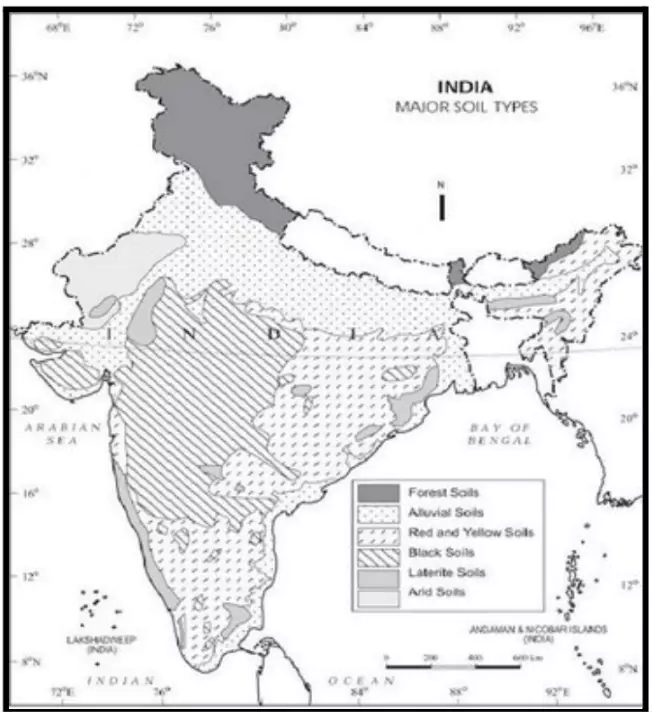India has moved from food aid dependency to becoming a top rice exporter with massive food distribution coverage. Yet, malnutrition persists—driven by degraded soils and fertilizer misuse—highlighting the urgent need for soil-focused nutrition reforms.
- Marking 10 years in 2025, the Soil Health Card Scheme has empowered farmers with tailored nutrient advice, improving soil fertility through a standardized, multilingual digital platform across India.
About Soil Health Card (SHC) Scheme
- It was launched to promote balanced fertilizer use and improve soil health.
- Provides personalised recommendations on soil health and fertiliser application. Helps address land degradation through soil testing.
- Implementation and Reach: Over 247 million SHCs distributed across the country. 8,272 soil-testing labs (STLs) established, including 665 village-level STLs (VSTLs) across 17 states.
- Decentralisation of STLs ensures farmers have access to timely and accurate soil-analysis results.
- Entrepreneur-led and self-help group (SHG) STLs enhance accessibility.
|
About Soil-Focused Nutrition Reforms
- Refers: Soil-focused nutrition reforms are a set of integrated agricultural practices and policy initiatives that aim to revive soil health to ensure the production of nutrient-rich food.
- Focus: These reforms shift the focus from yield maximization to nutrition-sensitive agriculture, recognizing that “Soil Health is Public Health.”
Concerning Data on Indian Soil Health

- Soil Degradation Extent: The Indian Council of Agricultural Research (ICAR) estimates that 37% of India’s land is affected by various forms of degradation, including erosion, soil acidity, and salinity.
- Overall Degradation: According to the Desertification and Land Degradation Atlas of India (SAC 2021), the current extent of land degradation in India is 97.85 million hectares (approximately 29.77% of the country’s total geographical area).
- Soil Loss: India loses an estimated 5.3 billion tons of soil annually due to water and wind erosion, severely impacting crop productivity.
- Soil Organic Carbon (SOC) Levels: Drastically declined from 1% to as low as 0.3% in the past 70 years.
- SOC refers to the carbon stored within soil organic matter, which typically comprises around 58% carbon.
- Deficiency: About half of India’s cultivable land is deficient in SOC.
- State-Specific Concerns: In states like Punjab, often considered the granary of India due to intensive farming, only 6.9% of soils had high organic carbon, and this percentage has further declined.
- Ideal vs. Actual: While the Indian Institute of Soil Science (IISS) suggests 0.5-0.75% SOC as adequate, World Food Laureate Rattan Lal advocates for 1.5-2% as ideal, highlighting the significant gap in most Indian soils.
- Imbalanced Fertiliser Use Worsens Soil Health: The overuse of nitrogen and underuse of phosphorus (P) and potassium (K) is a major concern.
- Punjab: 61% nitrogen overuse, 89% potassium underuse
- Telangana: 54% nitrogen overuse, 82% potassium underuse
- This imbalance has led to a drastic fall in the fertiliser-to-grain response ratio — from 1:10 in the 1970s to 1:2.7 in 2015.
- Environmental Consequences of Nitrogen Overuse: Only 35–40% of nitrogen from granular urea is absorbed by crops. The rest causes:
- Emission of nitrous oxide, a greenhouse gas 273 times more potent than CO₂
- Groundwater contamination via nitrate leaching
- Diversion and smuggling of subsidized urea
- Micronutrient Deficiencies: A comprehensive study of over 240,000 soil samples across 615 districts and 28 states revealed widespread deficiencies of sulfur (S) and micronutrients.
- Deficiencies of Sulfur (S), Zinc (Zn), and Boron (B) were higher compared to Iron (Fe), Copper (Cu), and Manganese (Mn).
- Average deficiencies across India:
- Zinc (Zn): 36.5% to 49% of soils (making it the most prominent micronutrient deficiency)
- Boron (B): 24.2% to 33% of soils
- Iron (Fe): 12.8% of soils
- Manganese (Mn): 7.1% of soils
- Copper (Cu): 4.2% of soils
- Molybdenum (Mo): 11-15% of soils
- Multi-nutrient deficiencies are also common, with occurrences of two-nutrient (e.g., S+Zn, Zn+B) and even three- or four-nutrient deficiencies in various regions.
- Other Factors Affecting Soil Health:
- Salinity: India has 6.7 million hectares of salt-affected land, resulting in an estimated loss of 11.18 million tonnes of crops annually.
- Groundwater Depletion: Agriculture accounts for about 87% of the total annual groundwater extraction (239.16 bcm in 2022), impacting soil moisture and fertility in the long run.
- Climate Change: Rising temperatures accelerate soil carbon loss. High to very high soil erosion zones are projected to rise from 35.3% to 40.3% by the century’s end due to climate change.
- Unsustainable Agricultural Practices: Monocropping, over-tillage, and burning of crop residues further degrade soil fertility and organic matter content.
The Soil-Health and Human-Health Nexus
- Soil and Nutrition – An Inseparable Link: The quality of food is intrinsically tied to soil health. Micronutrient-deficient soils lower both crop yields and nutrient density.
- Micronutrient Flow: Crops get essential nutrients from soil; humans depend on those nutrients for development and immunity.
- Example: Zinc-deficient soil leads to zinc-deficient crops, causing child stunting.
- 2024 Soil Health Card Survey: Nutrient-depleted soils lead to widespread deficiencies, even when caloric needs are met.
- A Soil Health Card survey (2024) revealed widespread nutrient gaps:
- Less than 5% of samples had sufficient nitrogen
- Only 20% had adequate Soil Organic Carbon (SOC)
- Deficiencies noted in sulphur, zinc, boron, and iron
- Urgent Need for Soil Restoration: Many Indian soils need intensive care unit (ICU)-level restoration to regain fertility and support nutritious food production.
- Safe Food Production: Healthy soils with active microbial life reduce uptake of harmful substances like heavy metals in crops.
Key Components of Soil-Focused Nutrition Reforms
- Smart Nutrient Management: Adoption of the 4Rs—Right Source, Right Dose, Right Time, and Right Place—for applying nutrients.
- This includes the use of organic manure, compost, biofertilizers, and balanced fertilization combining macro and micronutrients, reducing the dependency on synthetic inputs.
- Soil Organic Enrichment: Practices such as cover cropping, crop rotation, minimal tillage, and agroforestry enhance soil organic matter, improve water retention, and promote nutrient cycling.
- Enhancing Soil Biodiversity: A healthy soil microbiome supports plant health, boosts nutrient uptake, and strengthens resilience against pests and climate stress.
- Reducing Chemical Dependency: Promoting Integrated Pest Management (IPM), pest-resistant crop varieties, and natural pest control methods to reduce excessive use of chemical pesticides and herbicides.
- IPM is a sustainable approach to pest control that combines multiple strategies to minimize the use of pesticides and promote a healthy ecosystem.
- It emphasizes prevention, monitoring, and a combination of cultural, physical, mechanical, and biological methods, using chemical controls only when necessary.
- Soil Testing & Farmer Awareness: Wider access to soil health diagnostics and localized advisory services helps farmers understand nutrient deficiencies and adopt sustainable practices.
- Policy and Institutional Support: Government incentives, regulatory frameworks, and programs are crucial in enabling and rewarding sustainable soil management.
Why Do These Reforms Matter?
- Nutrient-Rich Crops: Healthy soils produce crops richer in micronutrients like iron, zinc, and selenium, directly addressing hidden hunger in populations.
- Food Security & Climate Resilience: Fertile soils yield more and withstand climate shocks better, ensuring long-term productivity.
- Economic Gains for Farmers: Reduced input costs, better yields, and premium prices for nutrient-rich produce enhance farmer incomes.
- Environmental Benefits:
- Carbon Sequestration: Healthy soils act as carbon sinks, helping mitigate climate change.
- Water Efficiency: Improved soil structure leads to better water retention and reduced irrigation needs.
- Reduced Pollution: Lower runoff from fertilizers and pesticides protects water bodies and ecosystems.
- Biodiversity Revival: Healthy soils support diverse above-ground and below-ground ecosystems.
- Public Health Benefits: Safer and more nutritious food directly improves human health and reduces healthcare burdens.
- The Supreme Court of India emphasized the right to life under Article 21 of the Constitution concerning public health hazards posed by unsafe food.
About India’s Food Journey: From Dependence to Global Leader
- Era of Dependency: In the 1960s, India relied on the U.S. PL-480 food aid, marking the infamous “ship-to-mouth” era.
- Export Powerhouse: By FY25, India became the world’s largest rice exporter. Exported 20.2 million tonnes (MT) out of the global 61 MT.
- Massive Food Security Net: Runs the world’s largest food distribution programme. The PM-Garib Kalyan Yojana (PMGKY) provides 5 kg of free rice/wheat per person/month to 800+ million people.
- Surplus Food Reserves: The Food Corporation of India (FCI) holds 57 MT of rice (as of July 1, 2025) — nearly 4 times the buffer norm of 13.54 MT.
Nutritional Security & Arising Dilemma
- Sharp Decline in Poverty: Extreme poverty fell from 27.1% (2011) to 5.3% (2022) (measured as earning less than $3/day, 2021 PPP).
- Persistent Child Malnutrition: Yet, malnutrition among children remains alarming (NFHS-5, 2019–21): Stunted: 35.5%, Underweight: 32.1% & Wasted: 19.3%
- Shifting Focus to Nutritional Security: Nutritional security, not just caloric sufficiency, is now the core challenge in India’s food security landscape.
Persistent Challenges that hinder comprehensive Nutritional Security
- High Malnutrition & Anaemia: NFHS-5 highlights that 36% of children under five are stunted, and 57% of women are anemic. India’s ranking of 111 out of 125 countries in the Global Hunger Index 2023 underscores this persistent issue.
- Double Burden: India faces a “double burden” of malnutrition, with 25% of adults being overweight/obese. The country has 77 million diabetic adults and 25 million prediabetics. Ultra-processed foods are easily available, while nutritious food remains unaffordable for many.
- Gender & Social Disparities: Women, particularly in rural areas, often eat last and least. Adolescent girls and elderly women are frequently excluded from targeted nutrition programs.
- Climate Change: Erratic monsoons, heatwaves, and droughts lead to crop loss and price spikes. The warmest February in 124 years significantly impacted wheat yields in 2024.
- Programmatic Gaps: 28% of PDS grains are lost to leakage. Many Anganwadi Centres lack basic amenities and adequately trained staff.
- Food Price Inflation: Food inflation consistently above 8% for months, with significant spikes in pulses and vegetables during 2023–24, strains household budgets for nutritious food.
- Urban Food Deserts: Poor urban areas often lack access to fresh fruits, vegetables, and proteins. A staggering 68% of packaged foods are high in sugar, salt, or trans-fats.
- Low Nutrition Literacy: 85% of the population is unaware of vegetarian protein sources, and 50% are unaware of healthy fats, highlighting a critical knowledge gap.
Measures to Enhance Nutritional Security
- Upgrade HWCs into Nutrition Resource Centres: Offer personalized counseling, NCD screenings, and locally tailored meal plans, including adolescents, the elderly, and migrant workers.
- Reform Mid-Day Meals: Incorporate local, seasonal, nutrient-rich foods. Link with Millets Mission, Farmer Producer Organizations (FPOs), and Self-Help Groups (SHGs) for decentralized delivery.
- Mandatory & Smart Fortification: Fortify essential staples like rice, milk, and oils in the PDS, complemented by dietary diversification.
- Make Urban Food Environments Healthier: Implement taxes on junk food, promote front-of-pack labeling (FOPL), and regulate fast food outlets near schools and health centers.
- Launch Mass Nutrition Literacy Campaign: Promote a “Right to Nutrition” through schools, workplaces, and media, utilizing influencers and community leaders for grassroots awareness.
|
Barriers to Implementing Soil-Centric Nutrition Reforms
- Low Awareness & Technical Knowledge among small and marginal farmers.
- Inadequate Infrastructure for soil testing, organic input production, and advisory services.
- Economic Barriers due to high initial costs or fears of short-term yield drops during the transition.
- Policy Mismatches where subsidies still favor chemical fertilizers and market incentives for nutrient-rich produce are weak.
- Fragmented Landholdings make community-level soil reform efforts difficult, especially in diverse agro-climatic zones like India.
Successful Interventions – India’s Efforts
- Soil Health Card Scheme (2015) – Personalized reports on soil nutrient status to guide fertilizer use.
- Neem-Coated Urea (2015) – Slow-release nitrogen improves efficiency and reduces environmental harm.
- PM Krishi Sinchayee Yojana (2015) – Promotes efficient water use critical for maintaining soil moisture and fertility.
- Mission on Agroforestry (2016) – ‘Har Medh Par Ped’ encourages tree planting on farms to recycle nutrients.
- Crop Residue Management (2018) – Converts crop stubble into organic matter instead of burning.
- Natural & Organic Farming – Growing emphasis in states like Himachal Pradesh, reducing chemical inputs.
- Sikkim holds the distinction of being India’s first “Organic State.”
- Nano-Urea & Nano-DAP – High-efficiency inputs applied in precise doses, reducing overuse.
- PM-PRANAM (2023) – Incentivizes balanced and sustainable fertilizer use.
- PM Dhan-Dhaanya Krishi Yojana (2025–26) – Supports region-specific natural farming, irrigation, and storage infrastructure.
- Composting and Vermicomposting – Encourages conversion of farm and urban waste into organic fertilizers.
Way Forward for Soil-Focused Nutrition Reforms
- Research Needs: Quantify the impact of soil practices on human nutrition.
- Study soil microbiomes and their influence on nutrient uptake.
- Technological Innovation: Internet of Things (IoT) Artificial Intelligence (AI), Geographic Information Systems (GIS)-based soil maps, and real-time farm analytics enable precision farming.
- Example: Uttar Pradesh, a major agrarian state, is actively implementing SHC and other central schemes. However, gaps persist in awareness, lab infrastructure, and farmer outreach.
- Meerut’s Agritech Hub represents a forward-looking effort to integrate technology, soil science, and nutrition into local agriculture, with potential to become a national model for soil-based food system reform.
- Policy & Finance: Reform input subsidies to favor organic and balanced fertilization.
- Reward farmers producing nutrient-dense crops through price premiums or nutrition-linked incentives.
- Promote Climate-Smart Agriculture: Shift from monoculture to millets, pulses, and biofortified crops. Amend the National Food Security Act (NFSA) to include nutrient-rich crops.
- The NFSA, 2013, is a landmark piece of legislation in India that aims to provide subsidized food grains to a significant portion of the population, ensuring food and nutritional security.
- It legally entitles up to 75% of the rural population and 50% of the urban population to receive subsidized food grains through the Targeted Public Distribution System (TPDS).
- Expand Social Protection: Add pulses, dairy, and millets to PDS baskets and provide DBT-linked nutrition support for vulnerable populations.
- Need for a Paradigm Shift in Agriculture: A fundamental change is essential — from merely maximizing yield to promoting nutrition-sensitive agriculture.
- Rigorous Soil Testing: To detect specific nutrient deficiencies.
- Customized, science-based fertilization suited to diverse crops and regions.
- Healthy Soils, Healthy People: The mantra emphasizes that healthy soils produce nutritious food, directly impacting human well-being.
- Adopt a cyclical approach: from “plough to plate” to “plate to plough and back”.
Global Soil Policy Shifts & Best Practices
- European Union: EU Soil Strategy 2030: Central to the EU Green Deal and Farm to Fork Strategy; promotes sustainable soil management and consistent monitoring frameworks.
- Common Agricultural Policy (CAP): Links direct payments to soil-friendly practices like crop diversification, ecological focus areas, and grassland conservation.
- Australia: National Soil Strategy (2021): A 20-year roadmap with three key goals:
- Prioritize soil health
- Foster soil innovation and stewardship
- Build soil knowledge and capability
- United States: Provides financial incentives and technical support to promote soil health principles—maximize biodiversity, cover crops, living roots, and minimize disturbance.
- Soil Health Institute: A non-profit accelerating adoption of soil health systems through research and outreach.
- China: National Soil Census, a comprehensive soil data collection to inform reforms addressing soil pollution and degradation.
- Policies emphasize sustainable agriculture and soil protection.
- Africa (Kenya, Niger, Benin, Burkina Faso): Focus on-
- Soil conservation and water harvesting (e.g., catchment approaches in Kenya)
- Integrated Soil Fertility Management (ISFM) in Niger
- Agroforestry and evergreen agriculture (trees in farming systems)
- Soil-enhancing crops like mucuna (Benin)
- Farmer Field Schools promoting IPM and sustainable practices
- Global Soil Partnership (FAO): Established in 2012, it’s a voluntary, multi-stakeholder platform promoting Sustainable Soil Management (SSM).
- Developed Voluntary Guidelines for SSM to aid policymakers and land users.
- Contributes to SDGs, especially Zero Hunger and Climate Action.
|
Conclusion
“A nourished nation begins with nourished soil, educated choices, and inclusive policies.” Soil-focused nutrition reforms are the foundation for a resilient, healthy, and equitable food system. By improving soil health, India not only nourishes crops, but also protects its people, supports farmers, and restores the planet. A soil-first strategy is thus essential for India’s food, nutrition, and climate security in the 21st century.
Read More About: Soil Types in India
![]() 21 Jul 2025
21 Jul 2025



